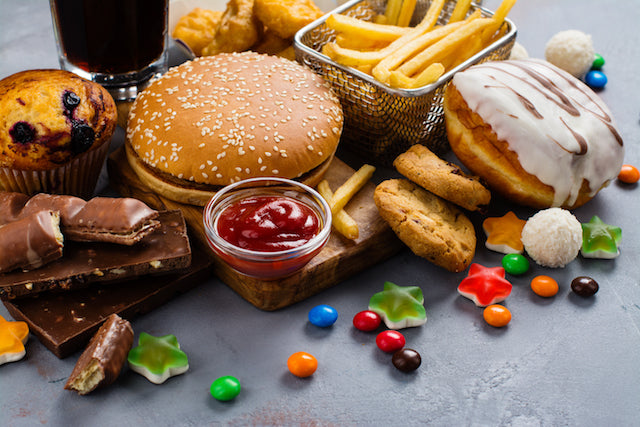The 12 Worst Ingredients In Your Toddler’s Foods

Everyone has heard of the ‘Dirty Dozen’ – You know, the list of 12 foods that you should be avoiding unless they are organic. But did you know that there are specific ingredients we need to be looking out for? Common sense tells us that the ingredient labels should be easy to read (containing actual foods), but our wallets and cravings steer us directly toward the opposite. We like to say ‘Everything in Moderation’ but the reality is that we are just addicted to it all. What’s worse? Our children are following in our footsteps.
I want to start by saying that I have 5 young children, and I completely understand budgeting and crying over grocery receipts. This article is not a way to point fingers or cause guilt trips; I truly hope that it is read with an open mind.
No one is perfect.
No one can raise their children in a bubble; unless of course you are off-grid somewhere laughing at the rest of us.
Chances are, your child has already ingested these ingredients at some point, but let’s not beat ourselves up over it. When you know better, you do better. You may be able to link certain behavior issues, health problems, or sleep troubles back to these ingredients – even potty training can be effected by these!
The Environmental Working Group has a list of the Dirty Dozen Food Additives, and it needs to reach the masses. Yes, this list is for all people, but I am writing specifically for this next generation we are raising. We are already addicted, and we can (and should) do better. We can start changing our ways, but for our children? They need to avoid these at all cost.
You see, these additives were not in our foods when we were children. Our toddler-time wasn’t filled with toxic add-ins. Our developing brains and bodies were not exposed to these additives at portions as large as these. If we stop purchasing items that contain these additives, it will send the message that we need better – that we are better than this.
Before I list these 12 ingredients, remember that the best option is always REAL food; organic being ideal. Processed foods, or foods with a longer shelf life are not truly meant to be a part of our diet…
The 12 Worst Ingredients In Children’s Foods
According to the EWG, “More than 10,000 additives are allowed in food. Some are direct additives that are deliberately formulated into processed food. Others are indirect additives that get into food during processing, storage and packaging.”
Their guide of harmful additives covers “ingredients associated with serious health concerns, additives banned or restricted in other countries and other substances that shouldn’t be in food.” For more details on each additive, visit EWG HERE.
1. Nitrites and Nitrates: Studies link non-naturally occurring nitrites to stomach, esophagus, brain, and thyroid cancers. The California Office of Environmental Health Hazard Assessment is currently considering listing nitrite in combination with amines or amides as a known carcinogen.
2. Potassium Bromate: Banned in the United Kingdom and Canada, this known carcinogen is used in bread and cracker dough to strengthen it. Potassium Bromate causes tumors at multiple sites in animals, is toxic to the kidneys and can cause DNA damage. Baking alters the bromate, but traces are still detectable.
3. Propyl Paraben: An endocrine-disrupting chemical that is known to lower sperm count and decrease testosterone levels, propyl paraben is also known to speed the growth of breast cancer cells and impair female fertility.
4. Butylated hydroxyanisole (BHA): “Natural Flavors” may umbrella this hidden danger. Another endocrine disruptor, BHA is listed as a known carcinogen under California’s Proposition 65.
5. Butylated hydroxytoluene (BHT): BHT is not a listed carcinogen, but research shows that it is linked to cancer in animals. Rats fed BHT have developed lung and liver tumors. Studies also show that BHT effects motor skills and coordination.
6. Propyl Gallate: A National Toxicology Program study reported an association with tumors in male rats and rare brain tumors in two female rats.
7. Theobromine: An alkaloid found in chocolate, bread, cereal and sport drinks. The average human consumption rate was five times higher than the level the company reported as safe.
8. “Flavors”: This means anything labeled ‘Natural Flavors’ or ‘Artificial Flavors.’ contain synthetic chemicals such as the solvent propylene glycol or the preservative BHA. These can include flavor extracts and ingredients derived from genetically engineered crops.
9. Artificial Colorings: Studies have found that mixtures of synthetic colorings and the preservative sodium benzoate are associated with hyperactivity. This is in addition to the links to cancer.
10. Diacetyl: Used as a butter flavoring in microwave popcorn (and other foods), it is associated with a severe and irreversible respiratory condition called bronchiolitis obliterans, which leads to inflammation and permanent scarring of the airways.
11. Phosphates: Fast foods and processed foods are full of phosphates. In people with chronic kidney disease, high phosphate levels are associated with heart disease and death. In others, they are linked to increased cardiovascular risk.
12. Aluminum: Additives containing aluminum, such as sodium aluminum phosphate and sodium aluminum sulfate, are used as stabilizers in many processed foods. Animals exposed to aluminum in the womb and during development show neurological effects such as changes in behavior, learning and motor response.
Apple slices for snack, anyone?







